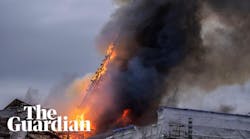The first Santa Anas of the season were expected to howl through the area Thursday evening, heightening the risk of wildfires, forecasters announced Wednesday.
The National Weather Service issued a red flag warning from Thursday night for coastal Ventura, Los Angeles and San Diego counties. This includes the San Fernando and Santa Clarita valleys, and the L.A. Basin to Long Beach.
"If fire ignition occurs," the weather service's Oxnard office warned, "the combination of critical fire weather conditions and very dry fuels will create the potential to bring rapid spread of wildfire."
Gusty north winds are expected to begin Thursday in western Los Angeles County, including Santa Clarita and the Santa Monica Mountains.
The so-called Devil Winds are then expected to shift to the northeast, kicking up early Friday to between 20-30 mph, with gusts of up to 45 mph.
By the afternoon, humidity is expected to plunge as low as 5 percent. Valley temperatures are expected to rise to 86 degrees in Woodland Hills.
The strongest winds are expected to blow through the Ventura coastal plain and from Malibu to the Hollywood Hills, forecasters said.
The Santa Anas should peter out Saturday afternoon.
"The Santa Anas are coming right on schedule," said Bill Patzert, climatologist at the Jet Propulsion Laboratory in La Ca ada Flintridge. "After an extremely dry and warm winter, and a sizzley August and September, moisture
content in the (hills) and grasslands are at record lows.
"All we need is an accidental ignition or a wacko pyromaniac and we're good to go."
The Santa Anas each fall and winter are caused by high pressure systems over the Great Basin Desert northwest of the Sierra Nevadas. Winds then blow out of the north and northeast, compressing as they descend from the hills.
This causes unseasonal heat, low humidity, and a danger of extreme wildfires.
Los Angeles has had less than 0.1 inches of rain since July 1. But because ocean weather systems don't signal the generally wet El Ni o or dry La Ni a winters for Southern California, rain can be hard to predict.
The so-called La Nada equatorial ocean temperatures can mean extreme rainfall, or nearly no rain at all.
La Nada brought a near-record 37.25 inches to downtown Los Angeles in 2004-05, and a record dry 3.21 inches in 2006-07. The average is 15.14 inches.
"Common sense would tell you that El Ni o is wet, La Ni a is dry and La Nada normal," Patzert said. "But normal is a cycle in a washing machine, and doesn't apply to Southern California."
Copyright 2012 - Daily News, Los Angeles
McClatchy-Tribune News Service





